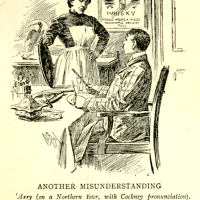 Oxford is a grand town. You can wander those cobblestone-streets forever, gazing up at the dreaming spires of one of the world’s great centres of learning. I have tried to give readers a flavour of the town as I read Harry Potter or haunted Inklings’ graves on a sunny Friday afternoon. I have visited churches, frequented pubs, held libraries hostage, and hiked the old hill where C.S. Lewis and his family lived, but it is truly difficult to catch the essence of the town with my meagre words and cheap camera.
Oxford is a grand town. You can wander those cobblestone-streets forever, gazing up at the dreaming spires of one of the world’s great centres of learning. I have tried to give readers a flavour of the town as I read Harry Potter or haunted Inklings’ graves on a sunny Friday afternoon. I have visited churches, frequented pubs, held libraries hostage, and hiked the old hill where C.S. Lewis and his family lived, but it is truly difficult to catch the essence of the town with my meagre words and cheap camera.
Recently, though, someone in the Tolkien Society shared a BBC Oxford video that can change our point of view. It is an aerial photograph that gives a 360° view of Oxford. WordPress won’t load the interactive photo, but if you click through to facebook you can see the picture. Scrolling over with your mouse will let you explore various sites of Oxford, but it is even cooler with your phone or tablet, as the camera rolls as you do.
When we do finally get to visit Oxford, we spend so much of our time with necks craned upward looking at the sites. With this facebook post, we can finally look down on Oxford town.
I believe in open access scholarship. Because of this, since 2011 I have made A Pilgrim in Narnia free with nearly 1,000 posts on faith, fiction, and fantasy. Please consider sharing my work so others can enjoy it.
Like this:
Like Loading...
Related

About Brenton Dickieson
“A Pilgrim in Narnia” is a blog project in reading and talking about the work of C.S. Lewis, J.R.R. Tolkien, the Inklings, L.M. Montgomery, and the worlds they created. As a "Faith, Fantasy, and Fiction" blog, we cover topics like children’s literature, myths and mythology, fantasy, science fiction, speculative fiction, poetry, theology, cultural criticism, art and writing.
This blog includes my thoughts as I read through my favourite writings and reflect on my own life and culture. In this sense, I am a Pilgrim in Narnia--or Middle Earth, or Fairyland, or Avonlea. I am often peeking inside of wardrobes, looking for magic bricks in urban alleys, or rooting through yard sale boxes for old rings. If something here captures your imagination, leave a comment, “like” a post, share with your friends, or sign up to receive Narnian Pilgrim posts in your email box.
Brenton Dickieson (PhD, Chester) is a father, husband, friend, university lecturer, and freelance writer from Prince Edward Island, Canada. You can follow him:
www.aPilgrimInNarnia.com
Twitter (X) @BrentonDana
Instagram @bdickieson
Facebook @aPilgrimInNarnia
 Oxford is a grand town. You can wander those cobblestone-streets forever, gazing up at the dreaming spires of one of the world’s great centres of learning. I have tried to give readers a flavour of the town as I read Harry Potter or haunted Inklings’ graves on a sunny Friday afternoon. I have visited churches, frequented pubs, held libraries hostage, and hiked the old hill where C.S. Lewis and his family lived, but it is truly difficult to catch the essence of the town with my meagre words and cheap camera.
Oxford is a grand town. You can wander those cobblestone-streets forever, gazing up at the dreaming spires of one of the world’s great centres of learning. I have tried to give readers a flavour of the town as I read Harry Potter or haunted Inklings’ graves on a sunny Friday afternoon. I have visited churches, frequented pubs, held libraries hostage, and hiked the old hill where C.S. Lewis and his family lived, but it is truly difficult to catch the essence of the town with my meagre words and cheap camera.





















And you can view it without logging in to Facebook.
Thank you for sharing this wonderful thing: my former home city from above. Where Logres comes closest to reality.
Great, I’m glad! I don’t love propping facebook.
So Oxford is where Logres & Britain come together? I like that.
There are doubtless many places where you can encounter Logres, but Oxford is one of them, in my experience 🙂
Wow, fascinating! ‘Things familiar seem strange’ (to misapply Williams’s Skeleton’s words)…
And, new vivid impressions of architectural symmetry (and, not quite symmetry, too)!
Yes, it’s neat when the symmetry breaks too.
Wow, it really is a “campus” in the original sense of the word – all those green fields, even if they’re enclosed by buildings. Which direction is the Bird & Baby?
Dana
If you swing to the right/clockwise, and go about 2 inches from where the Broad Street turns right, it’s about there (a little further than Pusey House, where the Lewis Society meets) – but Google Maps may be easier… 😉
I got there by Google maps but this way is fun too!
Kind of hard to describe, but up Magdalen st. 3 blocks up Cornmarket
Fun to see a different angle on the green spaces around the town. Kind of like being back up in the University Church of st Mary tower! I took a lot of picture up there, trying to to better stitch the geography together in my mind.
I wonder which towers which Inklings had been up? Magdalen Tower is a not insignificant feature of Dorothy Sayers’s Gaudy Night – but I can’t remember if I ever read or heard that Lewis (with or without guests) climbed it – on May Morning or otherwise. Did Tolkien – or Eliot – ever ascend Merton’s chapel? – lower than Magdalen, though both are kind of on different ‘edges of town’. In that sense, St. Mary’s would be the choicest, for a view in all directions – that or maybe St. Martin’s or ‘Carfax’ Tower, or, again, the ‘Saxon’ Tower of St. Michael at the North Gate – the one of which five, crazily enough, I’ve ever climbed being Merton’s. (And, which climbings around on which actual high places around St. Mary’s, Brasenose, and the Radcliffe Camera appear in that bit of Oxford in Young Sherlock Holmes (1985) when it was disguised as part of Victorian London? – I can’t remember… though I do remember the fake snow was not good for the grass!) It never occurred to me till now to wonder if people can climb the campanile of St. Barnabas, for yet another ‘edge of town’ perspective…
But I wonder when anyone first had a view anything like this one – with the first ascent of a hot air balloon in Oxford, whenever that was, I suppose.
Lewis was up both St. Mary’s and Magdalen, but I don’t know the rest. It’s hard to imagine missing it.
I just read Gaudy Night last year. Its featuring of Magdalen tower and other Oxford spots was a very fun bonus!
Oh, awesome. Did you go up either tower when there?
Oh, you know what we should do? An Oxford Books Series, featuring a short Oxfordish review of a book set in Oxford. You could do Gaudy Night!
That would be really fun! And would provide an excuse to actually buy a copy of the book, hehe.
The only tower I went up was St. Mary; will have to save Magdalen for another trip. There’s simply too much to do in Oxford…
I’m not sure how easily one gets to climb Magdalen Tower (stupidly, I never tried to find out for sure – and, whether it would have been easier while a past President of the Oxford Lewis Society was Chaplain, I don’t know either…).
There’s a whole sort of – what? ‘sub-genre’? – of Oxford Detective Stories – a series would be fun! As an avid, but slow, reader, I’m not sure how many I’ve missed,* but I have sadly not yet caught up with one by another past Lewis Soc President, A Murder in Michaelmas by Jeannette Sears:
https://jeanettesears.com/wp/?page_id=7
*I wonder if anyone has a handy list of ’em online somewhere? A whole batch a number of which I’ve enjoyed reading are those by someone who knew many an Inkling, Robert Bruce Montgomery (1921-78), writing as ‘Edmund Crispin’ – he wrote music as ‘Bruce Mongomery’ (including a piece dedicated In Memoriam C.W.). His Wikipedia article includes “A biography by David Whittle, Bruce Montgomery/Edmund Crispin: A Life in Music and Books (ISBN 0754634434) was published in June 2007, and a previously unpublished novella, featuring Edmund Crispin, will be included in the 2019 edition of the annual anthology, Bodies from the Library” – !
Oh, as well as buying a copy, think of listening to the Ian Carmichael audiobook version, sometime – I think he’s my favorite tv/movie Wimsey, and he also reads different character voices wonderfully.
This may be good hunting ground for Oxford Detective Novels – in this latest version updated two weeks ago!:
http://home.earthlink.net/~dbratman/infiction.html
Trying, in connection with the Aubade post, to see if a great little book I read about John Donne’s invention of stanza forms was in the Internet Archive (alas, without success), I stumbled upon a scan of “Dorothy L. Sauers Gaudy Night” attributed to John Donne as author – ! (on the basis of her epigraph from him):
https://archive.org/details/in.ernet.dli.2015.182122/page/n1
That’s funny! One of Kathryn Lindskoog’s books is embedded in Google Books within a study of snakehandling in the American south.
You never know.
I’ve never gone up!
Guess I’ll have to look through and see if any of my pics are worth sharing! It was a fun adventure to go up but very tight quarters up there—don’t think it was intended to have multiple groups climbing up and down at once 😂
Completely off topic here:
I am planning on a Lewis read in the next year as I am realizing I need to start seriously reading some theology oriented non-fiction. I’ve got several of Ellen White’s books on tap (being an Adventist) but her style is so late 1800’s that I can only handle it in small amounts. Hence Lewis interspersed between to ease me along.
I’ve got my eye on a collection from amazon that has the following books:
• Mere Christianity
• The Screwtape Letters
• The Great Divorce
• The Problem of Pain
• Miracles
• A Grief Observed
• The Abolition of Man
• The Four Loves
• Reflections on the Psalms
• Surprised by Joy
• Letters to Malcolm
My question is, do you know of a more complete collection for someone who wants the theological from Lewis and not just any and all Lewis related things?
Thanks!
Quick response – that looks like it has a lot of the theological and philosophical Lewis (as far as whole books rather than essays are concerned) – plus some of the most ‘theological’ fiction!
That’s a great collection! I’ve never seen one that complete. Can you read it in order of publication?
It is an omnibus edition on amazon, so I believe they are in the order listed.
Maybe they give the dates of original publication, somewhere…
I think I read Lewis jumping around a lot chronologically, depended what I ran into – though I think at least the Ransom ‘space trilogy’ in order. (I wonder if it’s the revised version of Miracles – I’m not sure which I read, first…)
It does sound like a great collection, though!
Once I get my hands on it, I’ll be reviewing the whole thing over the next year or two (probably closer to 3 really , considering my reading rotation). Would you find publication date a useful piece of datum?
If you wanted to read him in order of publication, or know which edition (and so, in some cases, if it had been revised by him) – though there are lots of things it may not tell us – for instance, he wrote most of the Narnia books earlier and faster than he published them. He also had ideas that interested him before he tried to put them in a book, so the first time he writes about something may not be the first time he thought about it….
Publishing can be a crazy old world – and probably has been since the invention of the printing press! – but it can be useful if a publisher tells you about the publication history of a book (though even then, a little detective work to double-check can also be useful – as I learned in the deligthful courses I took in analytical and descriptive bibliography!).
Oops! – not a deliberate error, but a typo like that ‘deligthful’ could help tell the difference between one printing or edition of a book and another…
You review a lot of books! I don’t know how you do it all. Best wishes, I’ll try to keep up (but will probably struggle this year as I finish by degree).
Thanks 🙂
It’s because this is my main hobby and not my job 😀
By the way, Arend Smilde’s detailed notes on various books are always handy – and this one points out some revisions in The Abolition of Man, among other things:
http://lewisiana.nl/abolquotes/index.htm
I agree, chronological is good. And the dates Arend gives are quite helpful. I wish I found him earlier.
He regularly updates with new information, too – so checking in every once and a while is a good idea! (I had fun helping with a quotation from a poem by Christopher Hassall in That Hideous Strength not so long ago, for instance…)
Pingback: Terry Lindvall’s Heavy Treatment of a Light Topic: A Review of Surprised by Laughter | A Pilgrim in Narnia
Pingback: On the Nobody Somebody Has Inside: C.S. Lewis and a Post About Bullying For Pink Shirt Day #pinkshirt | A Pilgrim in Narnia